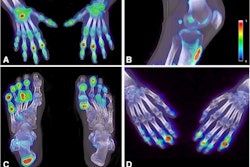This year's nuclear medicine and molecular imaging program at RSNA 2022 resounds with the impact of theranostics on the lives of patients with prostate cancer, with prostate-specific membrane antigen (PSMA)-PET imaging taking center stage. Organizers even saw fit to title one scientific session "Prostate and Theranostics Potpourri."
Among the medley are several sessions that discuss how PET imaging with gallium-68 (Ga-68) PSMA-11 improves patient management for most prostate cancer patients and how the use of F-18 DCFPyL (Pylarify) can help when selecting men under consideration for focal ablative therapy.
Moreover, in another session, researchers will describe how nomograms based on Pylarify PET/CT can help guide the selection of the most suitable patients for imaging, potentially reducing unnecessary medical expenses.
F-18 FDG-PET/CT imaging makes another strong showing at this year's meeting, with one study offering evidence that the approach can have a significant impact on initial staging, restaging, clinical management, and outcomes for patients with soft-tissue and bone sarcomas. Another discusses the impact of F-18 FDG PET/MRI on therapeutic management of women with newly diagnosed breast cancer.
Exciting results from studies of other PET radiotracers will also be presented. For instance, somatostatin receptor (SSTR)-PET/CT appears to outperform standard histopathology for detecting liver metastases in differentiated neuroendocrine tumors (NET), according to one study we've highlighted. In another, researchers from the U.S. National Institutes of Health suggest that F-18 fluorodopa (FDOPA) should be the radiotracer of choice among four evaluated for diagnosing adrenal gland tumors.
Also, artificial intelligence (AI) research appears to be taking shape in molecular imaging, especially in Alzheimer's disease. One study we've highlighted discusses the development of an algorithm that appears able to distinguish between normal and mildly cognitively impaired individuals and patients with Alzheimer's disease across several different amyloid PET tracers.
Meanwhile, in the meeting's Learning Center, attendees can choose from 35 education exhibits beginning on Sunday, November 27. We've highlighted two of these below. In one, a nuclear medicine physician from Fargo, ND, where temperatures average 3° F in winter, will discuss triaging frostbite injuries with Tc-99m methylene diphosphonate (MDP) multiphase SPECT. In another, an expert from the Mayo Clinic in Rochester will offer advice on detecting the most common emergent diagnostic challenges radiologists face on PET, with a focus on newer radiotracers.
Keep reading for more highlights of some of the many molecular imaging research presentations and posters scheduled for this year's meeting. You can view the complete list of abstracts for the 2022 scientific and educational program on the RSNA 2022 website.





















